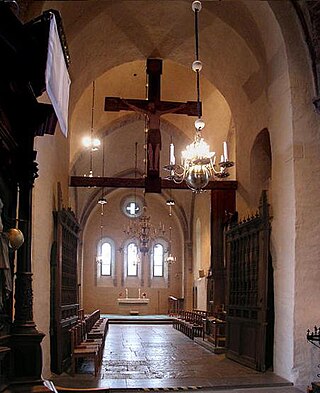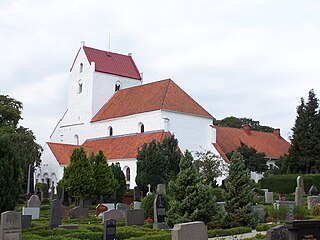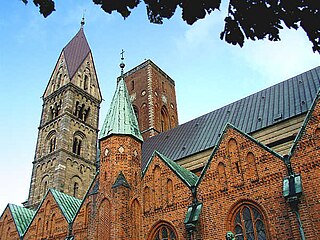
Sweyn Forkbeard was King of Denmark from 986 until his death, King of England for five weeks from December 1013 until his death, and King of Norway from 999/1000 until 1013/14. He was the father of King Harald II of Denmark, King Cnut the Great, and Queen Estrid Svendsdatter.

Eric I, also known as Eric the Good, was King of Denmark following his brother Olaf I Hunger in 1095. He was a son of Sweyn II. His mother's identity remains unknown. He married Boedil Thurgotsdatter.

Lund Cathedral is a cathedral of the Lutheran Church of Sweden in Lund, Scania, Sweden. It is the seat of the Bishop of Lund and the main church of the Diocese of Lund. It was built as the Catholic cathedral of the archiepiscopal see of all the Nordic countries, dedicated to Saint Lawrence. It is one of the oldest stone buildings still in use in Sweden.
Emund the Old or Edmund was King of Sweden from c. 1050 to c. 1060. His short reign was characterised by disputes with the Archbishopric of Bremen over church policies, and a historically debated delimitation of the Swedish-Danish border.

Stenkil was a King of Sweden who ruled c. 1060 until 1066. He succeeded Emund the Old and became the first king from the House of Stenkil. He is praised as a devout Christian, but with an accommodating stance towards the old Pagan religion. His brief reign saw an armed conflict with Norway.

Lund is a city in the southern Swedish province of Scania, across the Öresund strait from Copenhagen. The town had 91,940 inhabitants out of a municipal total of 121,510 as of 2018. It is the seat of Lund Municipality, Scania County. The Öresund Region, which includes Lund, is home to more than 4.1 million people.

Dalby is a locality and short-lived former Latin Catholic diocese situated in Lund Municipality, Skåne County, Sweden with 6732 inhabitants in 2019. It is located about 10 km East-southeast of Lund, and about 20 km East-northeast of Malmö.

Västgötalagen or the Westrogothic law is the oldest Swedish text written in Latin script and the oldest of all Swedish provincial laws. It was compiled in the early 13th century, probably at least partly at the instigation of Eskil Magnusson and was the code of law used in the provinces of Västergötland and Dalsland and in Mo härad during the latter half of that century. The earliest complete text is dated 1281. Small fragments of an older text have been dated 1250.

The Diocese of Skara is the oldest existing diocese in Sweden. It was originally a Latin bishopric of the Roman Catholic church, but since the Protestant Reformation has been a Lutheran diocese within the Church of Sweden, with its seat in Skara at Skara Cathedral. In 2014, it celebrated its 1000-year anniversary as a full diocese.

The former Diocese of Aarhus was a Roman Catholic diocese in Denmark, founded in the 10th century and dissolved during the Protestant Reformation. The diocese included the counties of Aarhus and Randers, the islands of Samsø and Tunø, and, after 1396, part of the county of Viborg.

The Diocese of Lund is a diocese within the Church of Sweden which corresponds to the provinces of Blekinge and Skåne. There are 217 parishes within the diocese, the most significant number in any of the dioceses of the Church of Sweden. The present bishop of Lund, Johan Tyrberg, succeeded Antje Jackelén in 2014.

The former Diocese of Børglum was a Roman Catholic diocese in Northern Jutland, Denmark. It has also been referred to as the Diocese of Vestervig or the Bishopric of Vendsyssel. The diocese included Vendsyssel, Hanherred, Thy, and Mors.

The former Diocese of Ribe was a Roman Catholic diocese in Southern Jutland, Denmark. The diocese was established in 948, and dissolved in 1536 during the Protestant Reformation. Within the newly established protestant Church of Denmark, the Diocese of Ribe effectively replaced its Roman Catholic precursor.

The Diocese of Aarhus is one of 10 dioceses in the Church of Denmark, with headquarters in the city of Aarhus. The diocese covers a large district of northeast Jutland and comprises 14 deaneries, of which four cover the extent of Aarhus city itself.

Dalby Church, sometimes also called the Church of the Holy Cross in Dalby is a church in Dalby, Lund Municipality in the Swedish province of Scania. It is one of the oldest churches in Sweden. When it was built Dalby was part of Denmark, and the church was commissioned by King Sweyn II of Denmark. It was constructed during the second half of the 11th century. For six years, it served as the seat of a bishop, before the diocese was merged with the Diocese of Lund nearby. The church was built with inspiration from Hildesheim Cathedral, and masons from Hildesheim appear to have worked on its construction site.

The former Diocese of Roskilde was a diocese within the Roman-Catholic Church which was established in Denmark some time before 1022. The diocese was dissolved with the Reformation of Denmark and replaced by the Protestant Diocese of Zealand in 1537.
Eric and Eric, according to Adam of Bremen, were two contenders for the kingship of Sweden around 1066–67, after the death of King Stenkil. They waged war on each other, with disastrous consequences: "[I]n this war all the Swedish magnates are said to have fallen. The two kings also perished then. When the entire royal clan was thus entirely extinct, conditions in the kingdom were changed and Christianity was disturbed to a high degree. The bishops that the Archbishop [of Bremen] had anointed for this land stayed back home due to fear of persecutions. Only the bishop in Scania took care of the churches of the Geats, and the Swedish Jarl Gnif strengthened his people in the Christian faith."
Christian was a bishop of the Diocese of Aarhus, Denmark, from c. 1060. Christian was the second bishop of the Ancient See of Aarhus and the first after almost a century of vacancy in the diocese. Christian is remembered for participating in one of the last viking raids on England in 1070. The dates of his birth and death are unknown, however it is assumed that he died sometime before 1102, when Ulfketil succeeded him as Bishop of Aarhus.

The Dalby Gospel Book is an 11th-century gospel book currently in the Royal Library of Denmark in Copenhagen. The illuminated manuscript derives its name from Dalby Church in Sweden, where the gospel book was used. During the Middle Ages, Dalby was part of Denmark. It is not known with certainty where the book was made; several researchers have suggested it was made in Dalby, while others point to present-day Germany as a probable place of origin. The manuscript is the earliest testimony of the presence of books and a culture of literacy in Denmark. The book contains four full-page miniatures with portraits of the Four Evangelists, 16 canon tables and a number of simple, red enlarged initials. Its gilt silver and copper binding is from the middle of the 12th century.















